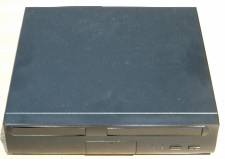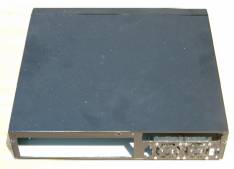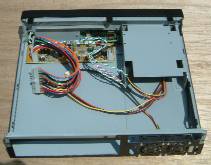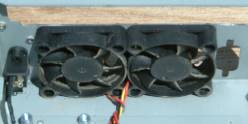
| Review - Cubid 2699R Mini-ITX Case |
The Cubid 2699R is a common offering for mini-itx motherboards, and is not much larger than the motherboard itself measuring only 295x270x63mm (WxDxH). There are a number of different models available for the different mini-itx motherboards, and they usually are available in black or white. We chose two black cases as we wanted to build a new router and webserver. Sometimes the case is called a Morex Cubid 2699 and sometimes a Casetronic 2699, but they appear to be the same.
 Whilst the case will take a full size (3.5") hard drive, it only supports slimline floppy and cdrom drives, which will add a little to the cost
if you want to use it for a desktop machine. As we were planning to use them for servers, we didn't need a floppy or cdrom drive. The cases come with an
external power supply brick, which just feeds 12v into the case, and will power upto 60w which given the low power of via's mini-itx boards is ample.
Whilst the case will take a full size (3.5") hard drive, it only supports slimline floppy and cdrom drives, which will add a little to the cost
if you want to use it for a desktop machine. As we were planning to use them for servers, we didn't need a floppy or cdrom drive. The cases come with an
external power supply brick, which just feeds 12v into the case, and will power upto 60w which given the low power of via's mini-itx boards is ample.
The big advantage of an external brick psu is that there is no need for a powersupply fan, which means the box will run quieter. In order to make a near silent system, we had chosen fanless via epia CL6000 motherboards (which have twin ethernet sockets), and near silent seagate hard drives with fluid dynamic bearings.
 The case is well put together and is suprisingly heavy as it uses a 0.8mm steel giving a robust feel. We were suprised to see two 40mm fans mounted on the back of
the case (more on that later) and the supplied feet are designed for mounting the case vertically not horizontally. We stuck some 7.5mm rubber feet on the bottom so we could mount it flat.
The case is well put together and is suprisingly heavy as it uses a 0.8mm steel giving a robust feel. We were suprised to see two 40mm fans mounted on the back of
the case (more on that later) and the supplied feet are designed for mounting the case vertically not horizontally. We stuck some 7.5mm rubber feet on the bottom so we could mount it flat.
 Fitting the motherboard was easy enough, with the supplied cables all being the correct length. Fitting the harddrive was a bit more complicated as there were a choice of holes in the drive bay for the mounting screws, but only one set of holes would allow the bay to fit back in the case.
Wanting a quiet as possible system, we decided not to bother connecting the case fans to the motherboard, and so when we switched it on, we were welcomed with the barely audible sound of the harddrive spinning up, and the click as the monitor switched on. Perfect.
Fitting the motherboard was easy enough, with the supplied cables all being the correct length. Fitting the harddrive was a bit more complicated as there were a choice of holes in the drive bay for the mounting screws, but only one set of holes would allow the bay to fit back in the case.
Wanting a quiet as possible system, we decided not to bother connecting the case fans to the motherboard, and so when we switched it on, we were welcomed with the barely audible sound of the harddrive spinning up, and the click as the monitor switched on. Perfect.
While installing the Operating System and software, we noticed the top of the case getting quite warm, and opening the case, found both the harddrive and cpu heatsink to be very hot to touch. I guess this is not surprising as the case was horizontal, and no air at all was flowing through it. No matter, we guessed thats why the supplied feet mounted the case vertically, so that air could flow throught it. There are vent slots on both sides, and the fan holes for the two 40mm fans on the back. So we mounted it vertically with the cpu at the top and hard disk at the bottom, as this meant the power cable socket was at the bottom of the case, and we continued the install. Well the sides of the case we no longer hot, but the top was very warm. Opening the case we now found the hard disk to be warm, but the cpu heatsink to be too hot to touch. I guess we would be needing those fans after all.
Turning the fans on, wow, what a noise. A real whoosh of air, but it certainly cooled the processor down a lot, and helped cool the hard drive a little. So we tried fitting a zalman fanmate fan speed controller, and that reduced the noise quite a bit. Enough that we could put up with, but we certainly no longer had our hoped for silent system.
 That should be the end of the story, but its not. After a few months the fans (those small 40mm case ones) started getting noisier. Odd rattles and vibration sounds started occurring. I guess 40mm fans aren't designed to run 24x7. So we fitted new fans. And that helped for a while, but they didn't last either. To solve the noise
problem I decided to move one of the boards to a fullsize atx case, with a quiet full size power supply. Ah peace at last. Not the silence I had envisioned when starting the project, but relative peace. So what of the Cubid case, well I removed the hard disk from the second system, and installed a compact flash card to boot linux off of, and disconnected the fans.
Now it runs truly silent, and the cpu does not get too hot at all. I think having a 12 watt harddrive in the case simply generated too much heat. The case is still mounted vertically, but now runs happily. Probably a small laptop harddisk would not overheat that case, but without fans I would recommend with using the network boot option of the via motherboard or a compact flash card.
That should be the end of the story, but its not. After a few months the fans (those small 40mm case ones) started getting noisier. Odd rattles and vibration sounds started occurring. I guess 40mm fans aren't designed to run 24x7. So we fitted new fans. And that helped for a while, but they didn't last either. To solve the noise
problem I decided to move one of the boards to a fullsize atx case, with a quiet full size power supply. Ah peace at last. Not the silence I had envisioned when starting the project, but relative peace. So what of the Cubid case, well I removed the hard disk from the second system, and installed a compact flash card to boot linux off of, and disconnected the fans.
Now it runs truly silent, and the cpu does not get too hot at all. I think having a 12 watt harddrive in the case simply generated too much heat. The case is still mounted vertically, but now runs happily. Probably a small laptop harddisk would not overheat that case, but without fans I would recommend with using the network boot option of the via motherboard or a compact flash card.
Conclusion
The cubid 2699R is a well built case, but is let down by poor airflow and unreliable noisy fans. A 3.5" hard drive partially blocks the holes designed to keep it cool. If anything larger than a very small pci card is fitted, such as a wireless or adsl modem, then because of the harddrive bay position the card can be bent up towards the top of the case, coming too close for comfort. We fitted a plastic barrier onto the inside of the case to prevent the back of the pci card from touching.
So if you want to fit a large pci card, don't fit a harddrive, and if you want to not use the fans, don't fit a 3.5" hard drive either. With the right setup the case works well and is silent, but in our opinion is not suitable for any system that needs a full size harddisk, as it either gets too hot or too noisy.
Overall Rating 6/10
Final Remarks
If the case were made 10mm wider, and one or two low speed, reliable (ie not thin) and quiet 60mm fans (maybe even temperature controlled) were fitted along a side, so air was sucked across the case over the hardrive, cpu and pci card, then the case may well make a perfect case for quiet mini-itx systems.
| running 2699 fanless | |
| found your site googling for "minimal linux flash boot". i have 2 epia-M systems running 100% fanless in 2699 cases. the trick is to remove the fans, put the case verticlaly (tower-style), with the disk drive at the bottom of the case, and make sure the support "feet" don't block the air vents. C3 can run much hotter than INTC or AMD, so as long as it's under 70C, it's stable. 3.5" seagate 7200.7 in one box keeps at 44-45C, 2.5" laptop drive in the other box is usually under 35C. i have no PCI cards to block the air flow and folded all cables and wires very flat and out of the airflow path. it still isn't utterly silent, because the 3.5" disk is too big to properly isolate from the case, while the 2.5" drive is currently a horrid seagate momentus with an annoying, tinny whiny squeal. now that 1GB CF costs less than a 2.5" drive and for a "smart router" i don't need even that much space, i am thinking of fixing this issue (and that's how i ended up at your site). hope this info can help you rehab your 2699 case :-) | |
| Posted 21 Mar 2005 by grandpa boris | |
